|
|
|||
|
(Back to Preceding Week; on to Next Week) |
|
|
|
|
|
All text & photos © Hilton Pond Center CALIFORNIA TRIP (Part 2):
Although we wandered around northern California for two weeks this month, most of that time we were based at Pacific Grove for a triennial Dressler Family Reunion. The Dresslers, descendants of world champion Holstein dairy farmers from Kansas (prize-winning cow Dora Pearl Veeman, below left, with distended udder),
All text & photos © Hilton Pond Center Located on California's Monterey Peninsula, Asilomar has beach and coastal trails, a short boardwalk loop through the natural dune preserve, and overnight lodging and conference facilities with great food and the friendliest service people we've ever met. Asilomar State Beach is a narrow one-mile strip of sandy beach and rocky coves; it and the conference center are within the boundary of 1.5-square-mile Asilomar Marine Reserve where all marine resources, animals, and natural features are protected. Park staff and researchers continually monitor the delicate balance between preservation and public access. Across from Asilomar State Beach is the 25-acre Asilomar Natural Dune Preserve--a restored coastal sand dune ecosystem--and next to it stands a small but productive greenhouse where more than 450,000 native plants from 25 species have been grown and transplanted to the dunes and coastal bluffs.
All text & photos © Hilton Pond Center Our introduction to Asilomar wildlife came just after we checked in. As we opened the sliding glass door to our second-floor deck for some fresh ocean air, a small flock of Western Scrub-Jays, Aphelocoma californica (above), immediately descended and almost entered the room. We took this as a good omen--having studied their relatives the Blue Jays, Cyanocitta cristata, over four years while in grad school in Minnesota--and snapped off a few photos while shooing the gregarious birds onto a lawn beside our lodging. Scrub-Jays, year-round residents at Asilomar, foraged all over the property for acorns, pine seeds, and insects--and for illegal handouts sometimes provided by OTHER park visitors. (Not us!)
All text & photos © Hilton Pond Center Several times at Asilomar--especially in late afternoon--we heard a light tapping noise that at first we couldn't identify. Pretty quickly we learned it was hoofbeats of a Black-tailed Deer and her fawn clicking on the asphalt walkways near our lodging. This duo was almost-but-not-quite oblivious to our presence, the protective doe always keeping one wary eye on us as we angled in for photos. Black-tailed Deer, Odocoileus hemionus columbianus, are a coastal subspecies of the closely related and similar-looking Mule Deer. These western browsers are distinct from our eastern congener White-tailed Deer, O. virginianus, and--as the name suggests--have black tails; Mule Deer relatives also have bigger ears than White-tails. Both these morphological characters are quite obvious in the photo above. 
All text & photos © Hilton Pond Center Nearly ubiquitous on the Monterey Peninsula are small, chubby rodents that at first glance look like Eastern Gray Squirrels. When startled, however, these critters run into holes in the ground rather than up the nearest tree trunk, indicating they are California Ground Squirrels instead. Upon closer examination the ground squirrels have a white saddle-like mark, the tail isn't quite bushy enough for a tree squirrel, and their "gray" pelage is actually brown with indistinct light spots. California Ground Squirrels, Spermophilus beecheyi, tend to be communal; some mammalogists report they spend their entire lives within a hundred feet of the burrow where they were born.
All text & photos © Hilton Pond Center Our report on Asilomar's "tame" wildlife would be incomplete without mentioning one particular female Raccoon, Procyon lotor, that apparently thought the facility existed solely as a place for her to turn over trash cans and root through suitcases of ground floor guests who left patio doors open for more than three seconds. (We fortunately had a second-floor room.) This masked bandit was quite adept at snatch-and-run foraging and thought nothing of wandering in to make herself at home with human guests. We never got a photo of the marauding 'coon, so we begged one (above) from Debbie Sturdivant--our hummingbird expedition coordinator at Holbrook Travel--who had been at a marine educator conference at Asilomar the week before we arrived. Debbie and the little beggar got to be good buddies by the end of her stay.
All text & photos © Hilton Pond Center We didn't see a lot of bird species while at Asilomar, nor did we observe many insects. (It didn't help that most of our July days there were breezy, quite foggy, and a bit chilly.) One afternoon, however, we noticed a swarm of Honeybees, Apis mellifera, on the wall of one of the lodges. A cedar shake had fallen off, revealing a hole the bee queen must have discovered. Workers were constantly entering and departing the hole, but only a few carried any pollen. (In the photo above, loaded pollen baskets appear on the rear legs of one bee at lower left). We watched the hive all week and were pleased to see no one from the Asilomar staff attempting to kill or evict the bees. Considering that many of California's native bees and wasps have been exterminated and the state's farmers must contract with South Carolina beekeepers to haul Honeybees 3,000 miles to pollinate California crops, it's probably it good idea NOT to discourage any wild hives such as this one.
All text & photos © Hilton Pond Center The first image (above) shows two semi-comatose Harbor Seals, Phoca vitulina, stretched out on the rocks, soaking up the sun's heat while letting UV rays do a number on external parasites. Obviously unconcerned are five Brandt's Cormorants, Phalacrocorax penicillatus, three of which are preening away as the seals slumber. Asilomar is a year-round home to three cormorant species: Brandt's, Pelagic, and Double-crested.
All text & photos © Hilton Pond Center The second photo proves the marine maxim: "The bigger the rock, the more pinnipeds." For being six feet long and weighing up to 300 pounds fully grown, Harbor Seals are surprisingly inconspicuous while they're sleeping. (How many can you find dozing in the photo above?) Note there is a great deal of individual variation in pelt color among these common marine mammals.
All text & photos © Hilton Pond Center To support all the animals described above--or at least the terrestrial ones--Asilomar also needs to have appropriate plant life; there's plenty of that in the form of shrub-tree forest and dune vegetation, although the vegetational structure undoubtedly looks different than it did when the YWCA first arrived in 1913 to find dense groves of live oaks and tall conifers. These days park personnel are working to save Asilomar's once-magnificent old-age forest of Monterey Pines, Pinus radiata (above), damaged heavily since 1992 by Pitch Pine Canker--an introduced fungal disease. This fungus attacks pines through wounds caused by storms or various bark beetles, so to offset loss of mature pines new trees are grown from seed. When a year old, seedlings are intentionally inoculated with a less-virulent strain of canker fungus.
All text & photos © Hilton Pond Center During the middle of the last century Asilomar's dunes became covered by Ice-plant and European Beachgrass, two non-natives intentionally introduced to stabilize damage from heavy grazing and foot traffic. About 25 years ago California Parks began eliminating these invasive flora and restoring native plant communities by planting locally grown seedlings of grasses, sedges, wildflowers, and shrubs; they also built boardwalks to allow limited dune access while keeping people from causing further destruction. As a result, Asilomar State Beach now has some of the best examples of native dune grasslands on California's central coast. Those folks who think of coastal dunes as big, barren piles of sand need only look at the photo above to see the extent and diversity of vegetation that will grow on dunes when they are protected.
All text & photos © Hilton Pond Center The most obvious plant in the two photos above is the gray-green Beach Sagewort, Artemesia pycnocephala, which is neither a sage nor a wort but a member of the Composite Family (Asteraceae); note its aster-like yellow flowers in the photo below left. Sagewort's jumble of fuzzy stems helps capture blowing sand that deposits at its base and slowly adds to the height of the dune on which it grows.
All text & photos © Hilton Pond Center Assisting sagewort in its sand-holding role are numerous other plants--especially Silver Beach Bur, Ambrosia chamissonis (another aster and a relative of our hay-fever inducing Common Ragweed) and leathery-leafed Yellow Sand Verbena, Abronia latifolia (above right), a member of the Nyctaginaceae (Four O'clock Family). It's interesting that sand verbena thrives in salt spray but does not tolerate an abundance of rainwater. A slow stroll along the Asilomar boardwalk reinforces the conjecture there truly are a great many kinds of plants on the dunes, so we thought we'd prove this with a set of flower photos, starting with the Beach Poppy below. Despite their species diversity, the images indicate there were numerous kinds of yellow blossoms and asters among the dunes. The majority are perennials.
California Beach Poppy, Eschscholzia californica maritima All text & photos © Hilton Pond Center
Pacific Gum Plant, Grindelia stricta platyphylla All text & photos © Hilton Pond Center
Lizard Tail, Eriophyllum staechadifolium All text & photos © Hilton Pond Center
Common Yarrow, Achillea millefolium All text & photos © Hilton Pond Center
Seaside Daisy, Erigeron glaucus All text & photos © Hilton Pond Center
Dune Buckwheat, Eriogonum parvifolium All text & photos © Hilton Pond Center
Seaside Painted Cup, Castilleja latifolia All text & photos © Hilton Pond Center
Tree Lupine, Lupinus arboreus All text & photos © Hilton Pond Center
Tree Lupine, Lupinus arboreus All text & photos © Hilton Pond Center
All text & photos © Hilton Pond Center The variety of flowering plants shown above is testimony to the great job state park staff, university researchers, students, and volunteers have done in restoring the windswept dunes at Asilomar State Park & Conference Center, and we wish them well in their additional efforts to save the majestic Monterey Pine forest from canker fungus. In any case, we had a great time in northern California and are hopeful this photo essay will give our readers a feel for what West Coast dunes were once like--and could be again.
All text & photos © Hilton Pond Center
Comments or questions about this week's installment?
Thanks to the following fine folks for recent gifts in support of Hilton Pond Center for Piedmont Natural History and/or Operation RubyThroat: The Hummingbird Project. Your tax-deductible contributions allow us to continue writing, photographing, and sharing "This Week at Hilton Pond." (Please see Support if you'd like to make a gift of your own. You can also contribute by ordering an Operation RubyThroat T-shirt.)
"This Week at Hilton Pond" is written & photographed You may wish to consult our Index of all nature topics covered since February 2000. You can also use our on-line Hilton Pond Search Engine at the bottom of this page. For a free, non-fattening, on-line subscription to |
|
Make direct donations on-line via
Network for Good: |
|
|
Use your PayPal account
to make direct donations: |
|
|
If you like to shop on-line, you please become a member of iGive, through which more than 750 on-line stores from Barnes & Noble to Lands' End will donate a percentage of your purchase price in support of Hilton Pond Center and Operation RubyThroat. For every new member who signs up and makes an on-line purchase iGive will donate an ADDITIONAL $5 to the Center. Please sign up by going to the iGive Web site; more than 200 members have signed up to help. It's a painless, important way for YOU to support our on-going work in conservation, education, and research. |
|
|
SPECIES BANDED THIS WEEK: NONE THIS WEEK * = New species for 2009 WEEKLY BANDING TOTAL 8 species 17 individuals YEARLY BANDING TOTAL (2009) 35 species 1,115 individuals 28-YEAR BANDING GRAND TOTAL (since 28 June 1982, during which time 170 species have been observed on or over the property) 124 species 52,997 individuals
|
OTHER NATURE NOTES OF INTEREST --We were away from Hilton Pond Center, in California, for the entire week.
|
|
|
|
(Back to Preceding Week; on to Next Week) Up to Top of Page Back to This Week at Hilton Pond Center Current Weather Conditions at Hilton Pond Center |
 You can also post questions for The Piedmont Naturalist |
Join the |
Search Engine for |
|
|

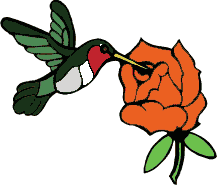 "HUMMINGBIRD MORNINGS"
"HUMMINGBIRD MORNINGS"
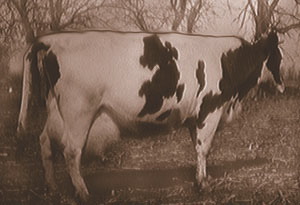 gather every three years in locales across the U.S., and 2009 was the first time we'd assembled on the West Coast. Our headquarters was the 107-acre Asilomar State Beach & Conference Grounds, created in 1913 by the YWCA as a girls' retreat but a state-run facility since 1956. Many of the park's rustic original buildings stand strong after nearly a hundred years, testimony to the design skills of Julia Morgan--one of California's first female architects and the woman who also designed the famous Hearst Castle. Asilomar--from two Spanish words meaning "refuge" and "sea"--was very much to our liking in that it offers a balance between the needs of people and wildlife. It was a neat spot for a family reunion AND a great place to relax and get closer looks at California coastal flora and fauna.
gather every three years in locales across the U.S., and 2009 was the first time we'd assembled on the West Coast. Our headquarters was the 107-acre Asilomar State Beach & Conference Grounds, created in 1913 by the YWCA as a girls' retreat but a state-run facility since 1956. Many of the park's rustic original buildings stand strong after nearly a hundred years, testimony to the design skills of Julia Morgan--one of California's first female architects and the woman who also designed the famous Hearst Castle. Asilomar--from two Spanish words meaning "refuge" and "sea"--was very much to our liking in that it offers a balance between the needs of people and wildlife. It was a neat spot for a family reunion AND a great place to relax and get closer looks at California coastal flora and fauna.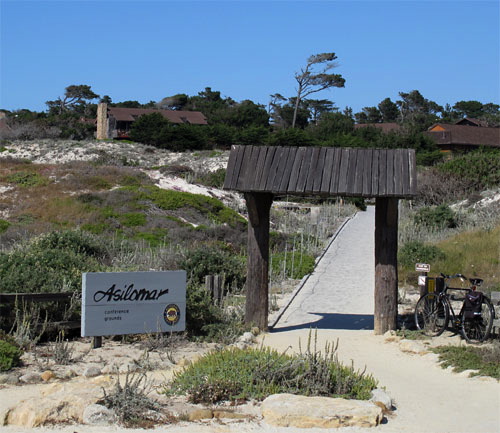
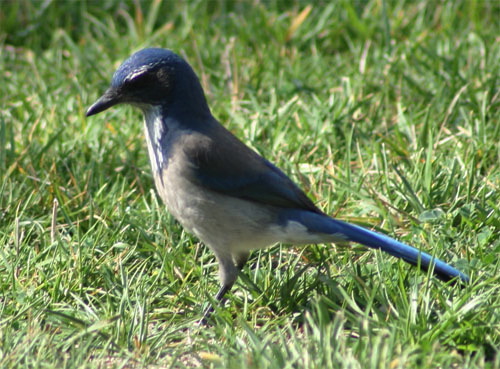


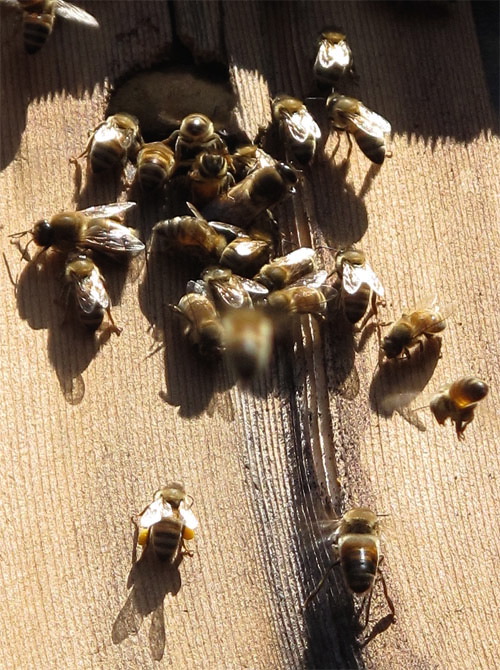
 One reason the Asilomar area was designated a marine reserve is because there are lots of rocks and plenty of kelp--any of several giant brown alga that can grow up to 18" per day. (A half-buried specimen, at right, washed up on shore was 20' long with a large green holdfast and several air-filled bladders that kept it erect under water.) The rock outcrops provide places for seabirds to roost and Harbor Seals to haul themselves out of the water, while the seaweed provides food and shelter for a wide variety of marine life. Because we were at Asilomar at the height of the summer tourism season, there were 'way too many people on the beaches and rocks to allow seals to come close, so we had to go to the very nice Monterey Bay Aquarium a few miles down the beach to get photos.
One reason the Asilomar area was designated a marine reserve is because there are lots of rocks and plenty of kelp--any of several giant brown alga that can grow up to 18" per day. (A half-buried specimen, at right, washed up on shore was 20' long with a large green holdfast and several air-filled bladders that kept it erect under water.) The rock outcrops provide places for seabirds to roost and Harbor Seals to haul themselves out of the water, while the seaweed provides food and shelter for a wide variety of marine life. Because we were at Asilomar at the height of the summer tourism season, there were 'way too many people on the beaches and rocks to allow seals to come close, so we had to go to the very nice Monterey Bay Aquarium a few miles down the beach to get photos.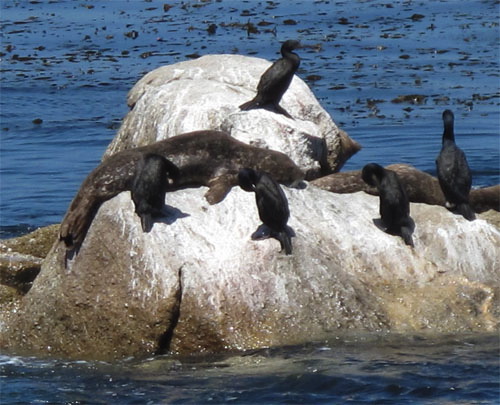
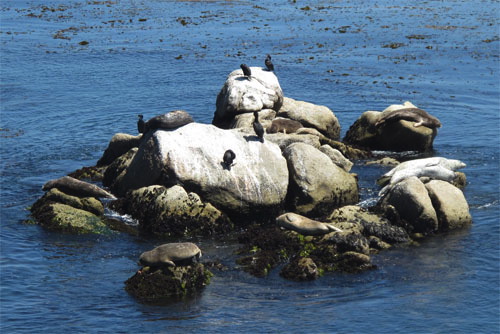

 After several months, a very small number of the seedlings (<4%) show natural resistance to fungus and are planted on Asilomar's grounds. (In most cases, Asilomar staff leave in place those adult trees that die; thus, the grounds are dotted with snags and fallen trees that provide homes for everything from woodpeckers to decomposers.) Incidentally, the remnant Monterey Pine forest in the town of Pacific Grove--where Asilomar is located--is prime winter habitat for Monarch butterflies. (Pacific Grove touts itself as a butterfly sanctuary and displays a Monarch statue, above right, in a city park.) No one knows what the loss of these mature trees would mean for migrant Monarchs.
After several months, a very small number of the seedlings (<4%) show natural resistance to fungus and are planted on Asilomar's grounds. (In most cases, Asilomar staff leave in place those adult trees that die; thus, the grounds are dotted with snags and fallen trees that provide homes for everything from woodpeckers to decomposers.) Incidentally, the remnant Monterey Pine forest in the town of Pacific Grove--where Asilomar is located--is prime winter habitat for Monarch butterflies. (Pacific Grove touts itself as a butterfly sanctuary and displays a Monarch statue, above right, in a city park.) No one knows what the loss of these mature trees would mean for migrant Monarchs.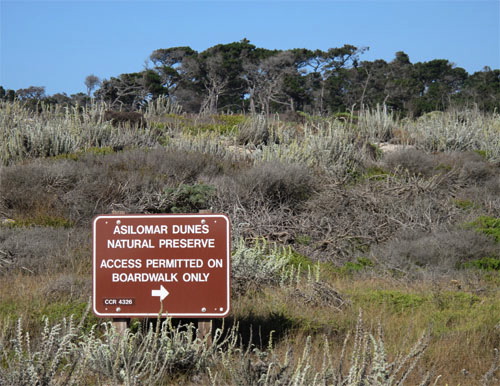

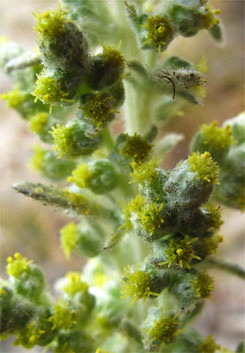 ..
..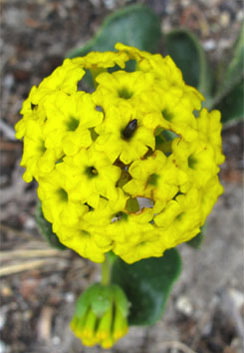

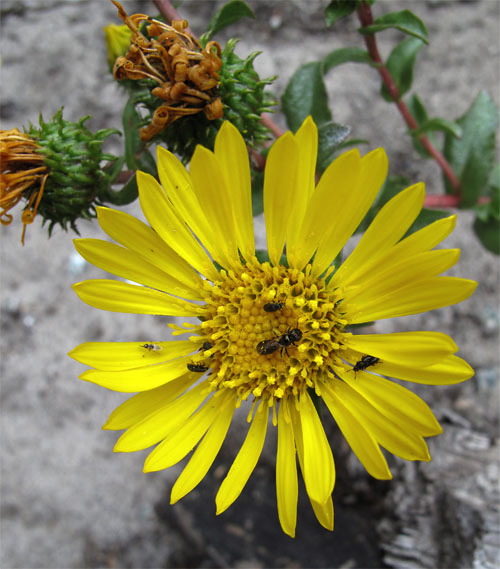


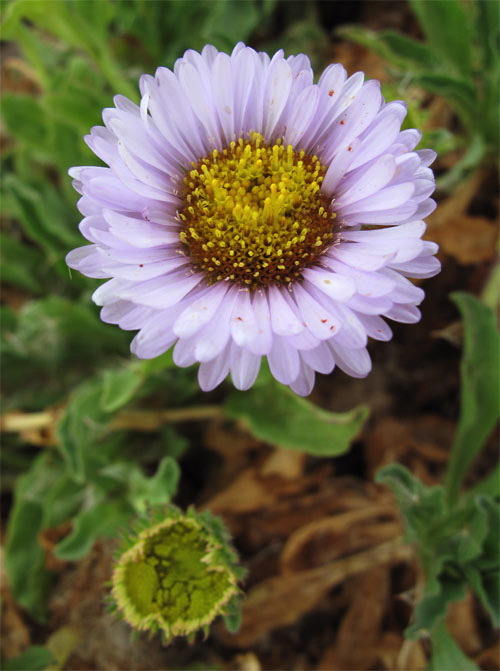
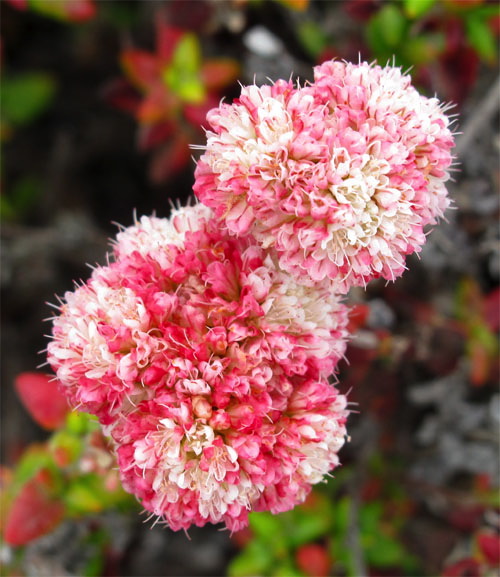
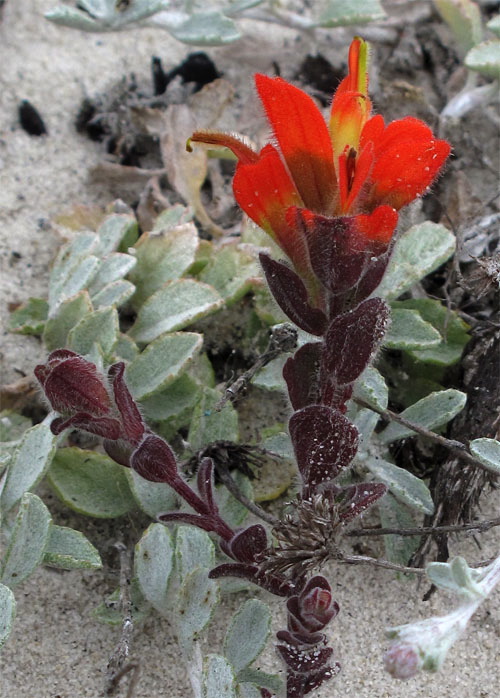

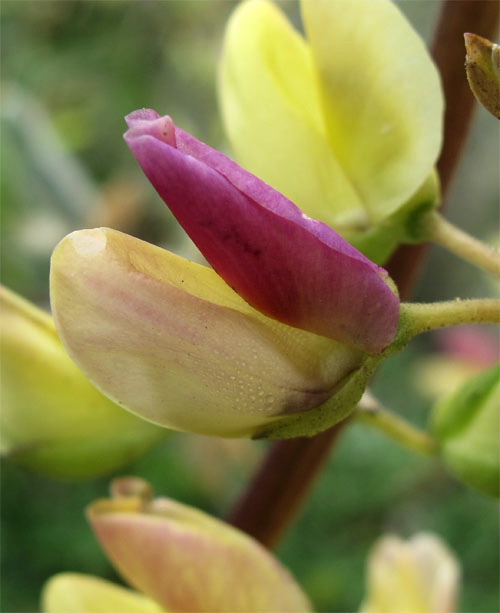
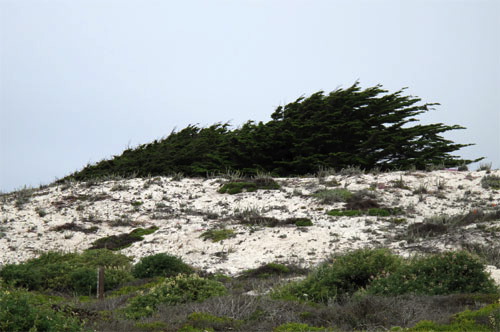
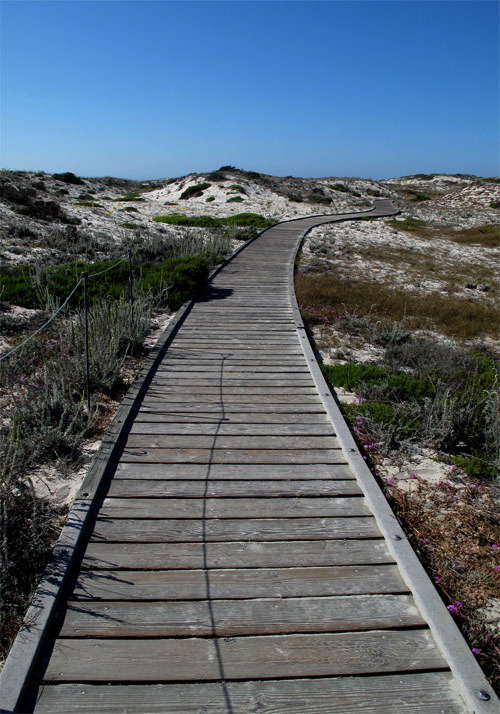



 Please report your
Please report your